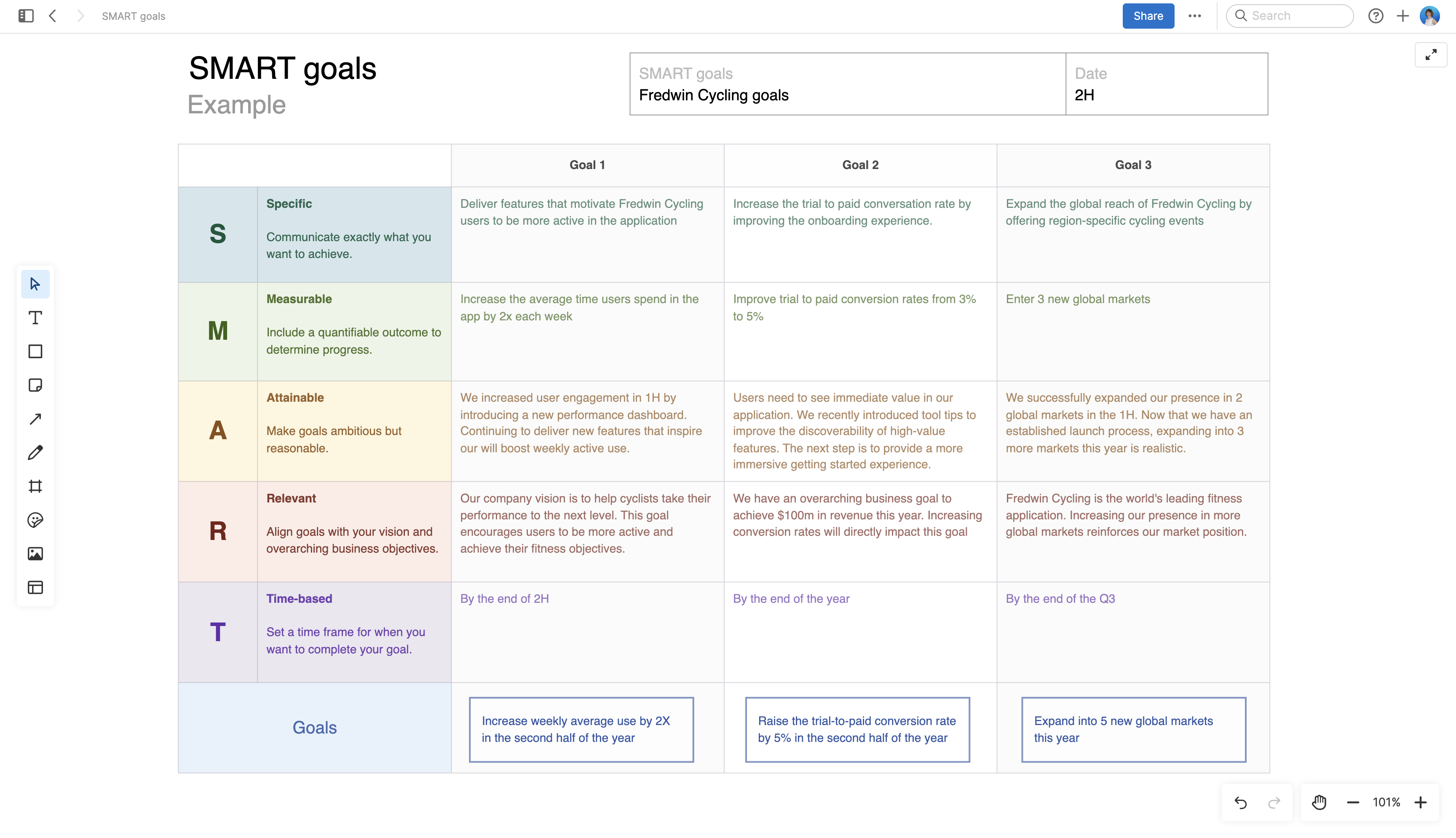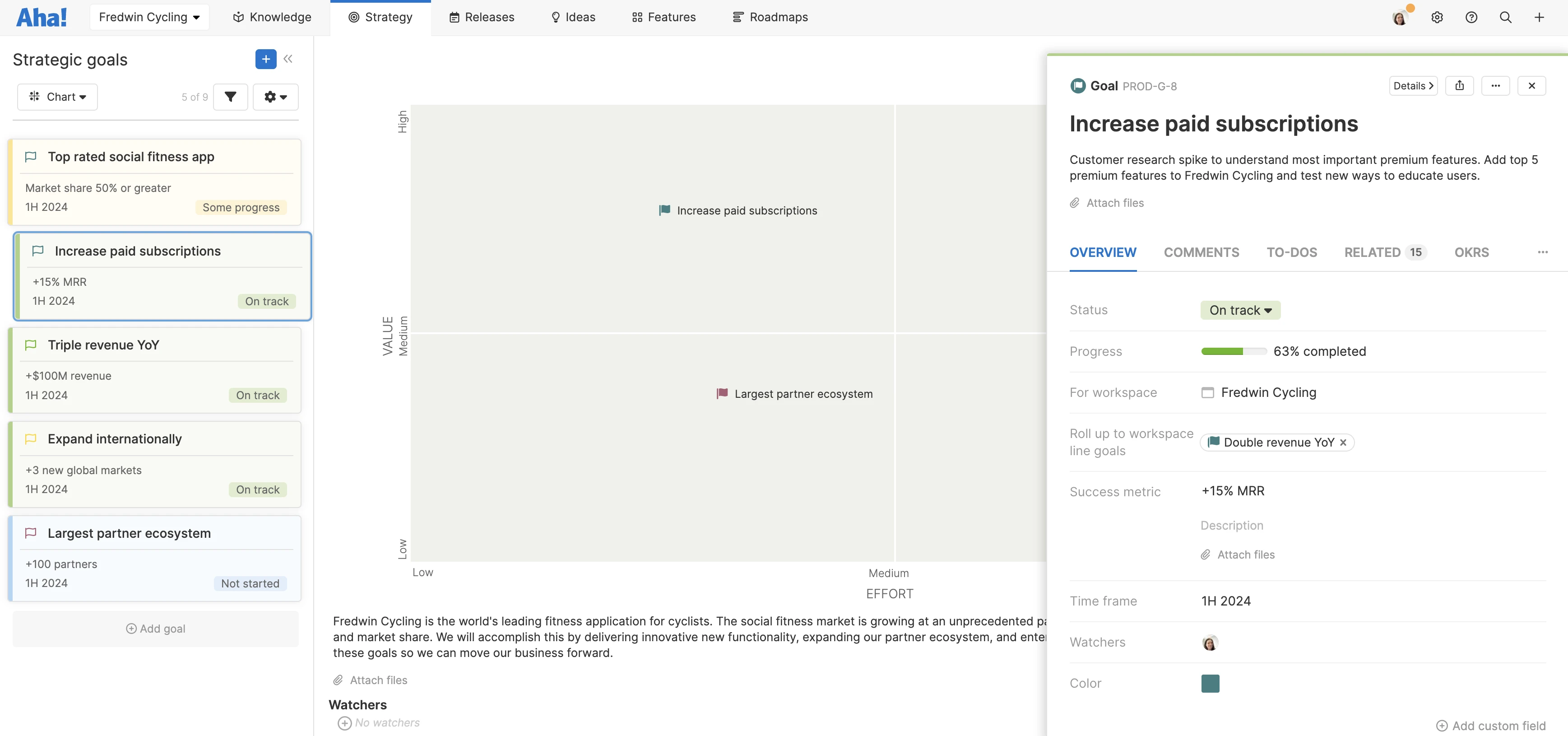How to set marketing goals
Goals are an essential component of your marketing strategy. They are often the place you start. Goals set the direction for what needs to happen for your product or service to do well in the market and are the foundation of the plan you build to get there.
The purpose of marketing is to reach your target audience and communicate the benefits of your product or service — so you can successfully acquire, keep, and grow customers. So, your marketing goals must relate to the specific business objectives your company wants to achieve. A top-down hierarchy of goals keeps your marketing plan aligned with the business strategy and shows the impact of marketing.
Setting focused, realistic, and quantifiable goals upfront establishes a true north for your marketing efforts. This demonstrates the strategic importance of what the team is working on and empowers you to show leadership why your marketing plan is the best approach.
Jump ahead to any section:
Marketing goal frameworks
Many organizations use a goal management framework to set marketing objectives. Frameworks provide a structured approach for creating relevant and actionable goals. Some of the most popular frameworks include mnemonic devices to help teams remember the elements.
Here are a few popular goal-setting frameworks:
CLEAR goals
CLEAR is a goal-setting approach that combines logical and emotional reasoning. CLEAR goals recognize the collective power of the team in achieving outstanding results and focus on emotionally engaging people in the work they do.
Collaborative | Create goals collaboratively to drive momentum and internal buy-in. |
Limited | Set goals that are limited in scope and duration. |
Emotional | Choose words that make an emotional connection with the team, so everyone embraces them with energy and passion. |
Appreciable | Be ready to break large goals down into tactical action items. |
Refinable | Be willing to refine and modify your goals in response to new situations and findings. |
OKRs
Objectives and key results (OKR) is a management framework for setting company, team, and employee objectives. Three to five objectives are defined at each level and associated with key results. Objectives are often set on a quarterly basis and reviewed monthly or weekly.
Objectives | Define three to five objectives that are qualitative, time-bound, and actionable. |
Key results | Quantify each objective by setting three to five results that are based on things you can measure. |
SMART goals
SMART is an acronym that stands for specific, measurable, attainable, relevant, and timebound. Using the SMART structure to set goals helps you identify exactly what you want to accomplish so you can deliver against your strategy.
Specific | Define goals that are clear and unambiguous so the team understands what you want to achieve and why. |
Measurable | Identify a quantifiable outcome so you can measure progress and determine if you meet the goal or not. |
Attainable | Set goals that are challenging but possible to achieve, taking available resources and potential obstacles into consideration. |
Relevant | Relate your marketing goals with the company’s overall vision and mission. |
Time-bound | Establish a start and end date to create a sense of urgency and help the team plan what can be accomplished during the time frame. |
Many templates exist that can help you get started with different goal frameworks. For example, the SMART goals template in Aha! software includes guided examples for setting clear objectives for your team. Give it a try.

Elements of a marketing goal
Regardless of the framework your organization chooses to use, what matters is defining goals in a way that clearly communicates what you want to accomplish and defines the criteria for success.
Marketing goals should include a description of impact, metrics for success, time frame for completion, and supporting initiatives:
Description of impact
Defining a clear description of what you want to achieve and why it matters is key to achieving the desired outcomes. It helps everyone contributing to the goal to understand exactly what needs to be done and sets a clear scope for making effective prioritization decisions.
Metrics for success
Establishing a success metric for each goal gives you a clear way to measure progress and determine if the team meets the goal or not. The metric you set should be challenging but possible, taking into consideration the available resources and any potential obstacles.
Time frame for completion
Establishing a time frame for completing marketing goals creates a sense of urgency and helps the team plan what they can realistically accomplish. Each goal should have a start and end date so you can see how you are tracking against it and review your overall success at the end.
Supporting initiatives
Initiatives describe the high-level work required to achieve your goals. They are big efforts — such as themes or projects — that the team will implement during a specified time frame to deliver against your marketing strategy.

Setting effective goals
The most effective marketing goals directly align with the direction of the company. For example, if a company has a business goal to increase revenue from customers in Europe by 30 percent, marketing should set a goal to drive more leads in that geography. Following this top-down approach ensures your marketing goals are relevant and demonstrates how your efforts will propel the business forward.
Taking our previous example, here is how to define a marketing goal to increase leads in target countries in Europe to help the business meet its revenue objectives:
Description: Increase the number of leads generated in England, France, Italy, and Spain Success metric: +500 leads a month Time frame: 2019
The goal described in the example above makes it clear what needs to be achieved. The marketing team can then determine how they will achieve the goal — such as by launching a localized digital advertising campaign that targets specific countries.
Here is an example of how to set a marketing goal to achieve a business objective of increasing overall market share in the upcoming year:
Description: Rank number one on Google for key search terms Success metric: #1 ranking for our top five keywords Time frame: Q2-Q3
In the example above, ranking first for specific keywords will drive more organic visits to the company’s website. The marketing team can create a plan to boost the company’s ranking by delivering content optimized for search engine. This increases awareness of your products and services so you can acquire new customers and grow your overall market share.
This example shows how to create a marketing goal focused on increasing revenue from existing customers:
Description: Drive more add-on sales to existing customers Success metric: 10 percent of existing customers upgrade to premium-level plan Time frame: Q4
The goal above focuses the marketing team on activities that will motivate customers to upgrade to their account. Based on this goal, you might prioritize an email campaign or webinar that targets existing customers, explains the benefits of upgrading — to drive more add-on sales.
How to set success metrics for marketing goals
Establishing clear success metrics for your marketing goals is essential for driving the desired results. The metrics you choose determine how the impact of marketing is measured and give the team clarity on the outcomes they are working towards.
Try to focus on the following characteristics:
Business-driven Select marketing metrics that contribute directly to your company’s growth and align with how your company’s overall business objectives are measured.
Improvable Make sure you pick metrics that have potential for improvement so you can track progress against them and see the impact of your work.
Actionable Your success metrics should inspire action so the team knows where to focus and what to do to achieve the desired outcomes.
Once you have defined success metrics for your goals, you can use various performance indicators to monitor how your activities are performing against those goals. This helps you understand the effectiveness of your programs and campaigns, so you can adjust your plans as needed to achieve the best results.
Here are some examples of commonly used metrics for online marketing activities:
Bounce rate
Channel-specific traffic
Click-through rates
Conversions
Cost per lead
Lead to close ratio
Marketing leads
New sessions
Page views
Session duration
Social media mentions
Time on page
Total visits
Make sure your goals are accessible to the team — so everyone knows what they are striving for. You can download these Excel and Powerpoint marketing strategy templates to communicate your goals. Or try a web-based tool like Aha! Roadmaps to create goals and connect them to your day-to-day activities.
Build marketing plans like you always wanted. Sign up for a free 30-day trial.